Pilatus PC-9
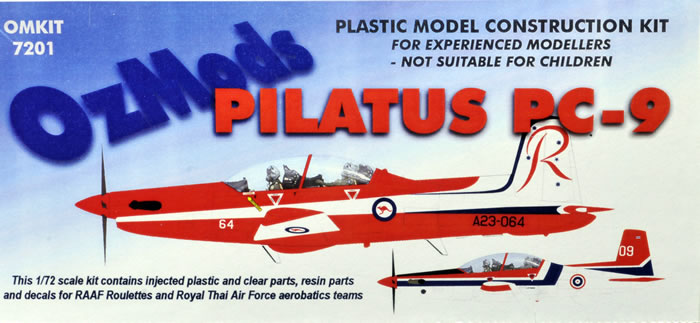
OzMods, 1/72 scale
S u m m a r y : |
Catalogue Number: |
OzMods Kit No. OMKIT 7201 – Pilatus PC-9 |
Scale: |
1/72 |
Contents & Media: |
One clear and twenty-four white styrene parts, eleven resin parts, two vac-form canopies, and decals for two air forces covering multiple aircraft serial numbers. |
Price: |
Available online from OzMods for AU$39.60, or contact these stockists: Hannants & Red Roo Models. |
Review Type: |
First Look. |
Advantages: |
Choice of canopy media and excellent decals. |
Disadvantages: |
Soft undercarriage detail; and the injected canopy needs a good polishing. |
Conclusion: |
This is a generally nice limited-run kit. The low-pressure parts will need a bit more prep than say a modern Czech limited-run kit, but they are well in advance of older-style limited-run kits like 90’s Merlin or Ventura; so don’t be put off. A little work ensuring a good fit and nice surface finish should result a good model.
Price no doubt reflects modest sales volumes, making the kit a bit more expensive than a long-run equivalent. However, I think it is reasonable for what is on offer, and should be generally affordable for those who want a PC-9 in their collection
Recommended to PC-9 fans in The One True Scale! |
Reviewed by
Mark Davies

Sword's 1/72 F2H-2P Photo Banshee and F2H-2 Banshee
are available online from Squadron.com
The PC-9 is a more powerful evolution of the PC-7. It retains the overall layout of its predecessor, but it has very little structural commonality with it. Amongst other improvements, the PC-9 features a larger cockpit with stepped ejection seats and also has a ventral airbrake.
The PC-9 program officially started in 1982. Although some aerodynamic elements were tested on a PC-7 during 1982 and 1983, the first flight of the first PC-9 prototype took place on 7 May 1984. A second prototype flew on 20 July of the same year; this prototype had all the standard electronic flight instrumentation and environmental control systems installed and was thus almost fully representative of the production version.
Certification was achieved in September 1985. By this time, the PC-9 had lost the RAF trainer competition to the Short Tucano. However, the marketing links that Pilatus built up with British Aerospace during the competition stood them in good stead, as it soon led to their first order from Saudi Arabia.
As of 2004, more than 250 aircraft of this type have been built.
Source: Wikepedia.
Contents
The kit comes in a hinged top-opening box with pasted-on artwork. The contents are packed in several zip-lock plastic bags, and include three sprues of limited-run white styrene parts, various grey-green resin pieces, two vac-form and one styrene canopies, and a sheet of decals. There are also three A-4 sheets of instructions, one of which is printed in colour.
The instructions dedicate a whole page to safety and working with the kit’s materials, whilst the reverse side has a photographic parts map. It also includes a diagram and notes covering the kit’s provision of two sets of prop blades. One has all four blades moulded as a single piece for engine running, whilst the other has four separate blades that can be assembled fully feathered; as found with a shut-down engine. The second page uses clearly drawn diagrams to illustrate assembly, along with appropriate notes. A nice touch here is specific guidance of the amount of weight needed for nose ballast. There are also quite lengthy notes on the use of Future to improve the appearance of canopies; plus a list of the other items available from OzMod’s product range. The final sheet is a colour-printed painting and markings guide, along with paint colours cross-referenced either to FS-595 or the Modelmaster paint range.
The Kit
The sprues are low-pressure mouldings either from a resin tool, or possibly even a rubber one, as used by Ventura. The style is similar to, but cleaner than Ventura, and also reminds me a bit of the old High Planes kits before they began to tool-share with PJ Productions using metal moulds.
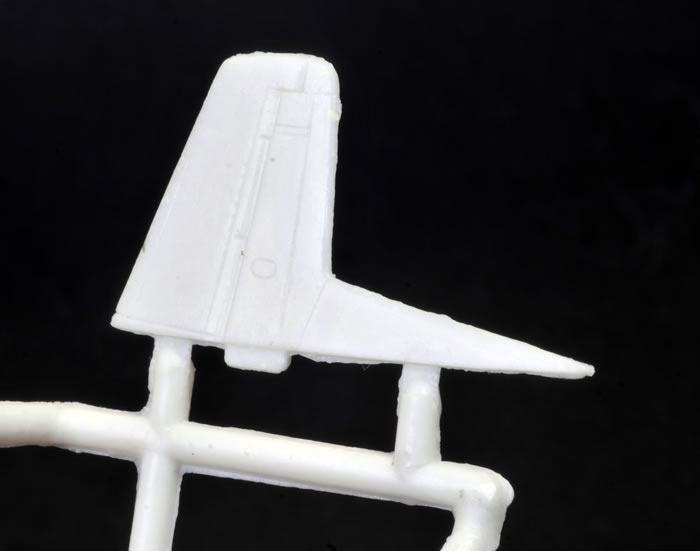
Recessed panel detail on the wings is actually very finely done, whereas that on the fuselage is a little less so, but still quite acceptable. Some areas of the soft plastic mouldings are scratched and will need polishing up. I suspect the plastic will prove to be a little cheesy, so finer grit papers and water are called for when sanding. It goes without saying that there is a little flash to clean up. Detail on the undercarriage legs and wheels is a little soft; but not enough to detract too much.
The resin is cleanly cast, and adequately mastered; the most noticeable detail being the seats, which look quite nice.
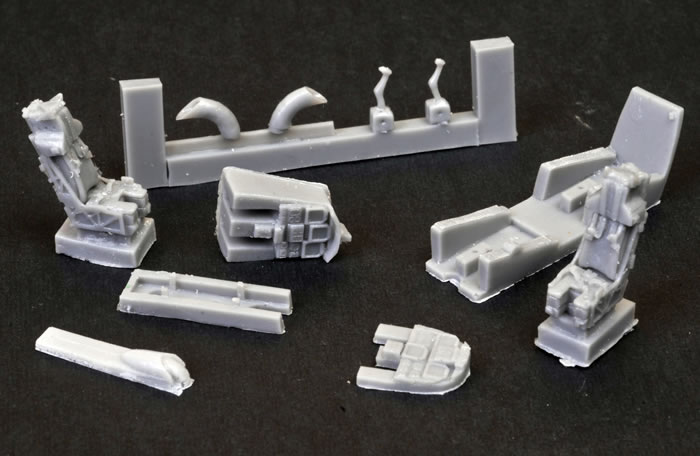
The two vac-formed canopies are fine, and should be easy to cleanly remove from their backing.
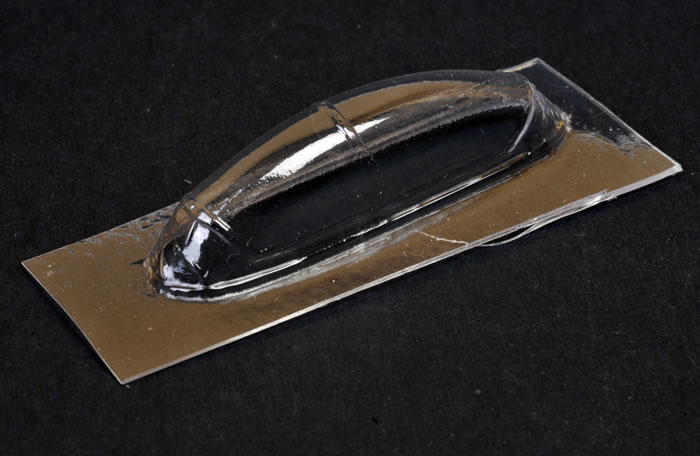
There is also an injected canopy for those who dislike the vac-type. The injected canopy will need a fair bit of polishing to remove scratches and improve its clarity; personally, I would use the vac-form option.
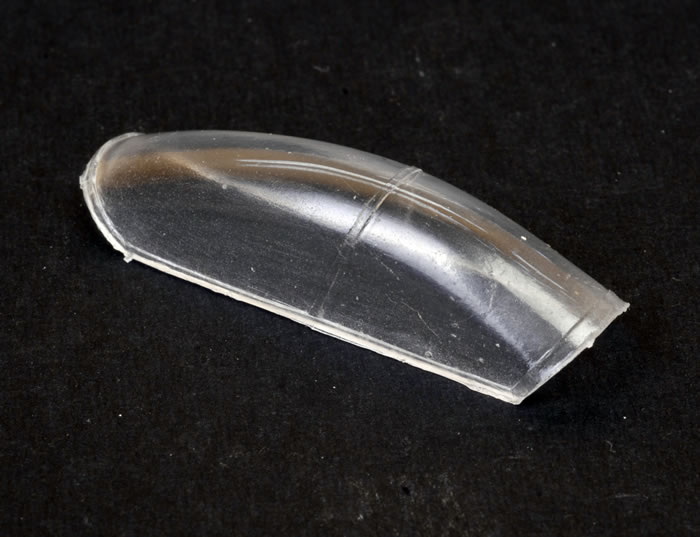
Airframe assembly is completely conventional for the type, but will no doubt require a reasonable amount of dry fitting and fine adjustment. Resin serves for the turbine’s exhaust pipes, and alternate open or closed nose wheel-wells. Cockpit detail is also provided by the resin parts, which include a tub, seats, instrument panels, and control columns. All should be quite visible through the relatively large and clear canopy. If you insist on using the injected canopy make sure you really polish it up to improve its appearance. Providing two vac-form canopies (for practice or insurance) as well as an injected canopy is a nice touch.
Careful assembly and fixing of any surface blemishes should result in a nice little model.
Marking Options
OzMods provides markings for either the RAAF or Royal Thai AF aerobatic teams.
The decals are quite comprehensive, and include the various stripes and wing-walk markings required for the schemes offered; as well as the expected national insignia and safety stencilling.
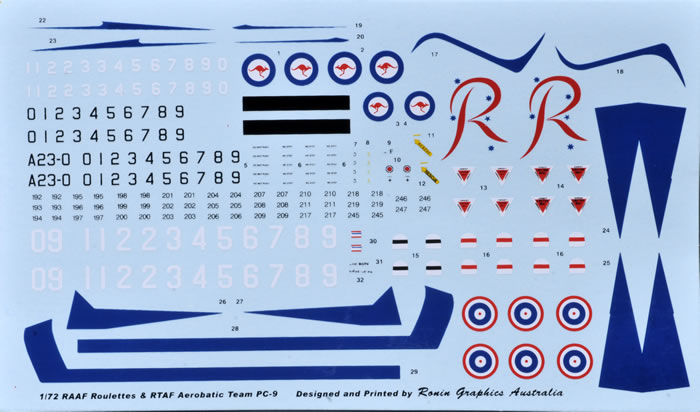
Sufficient serial numbers are provided to presumably cover any aircraft in service with either air force’s aerobatic team.
The decals appear well printed by Ronin Graphics Australia.
This is a generally nice limited-run kit. The low-pressure parts will need a bit more prep than say a modern Czech limited-run kit, but they are well in advance of older-style limited-run kits like 90’s Merlin or Ventura; so don’t be put off. A little work ensuring a good fit and nice surface finish should result a good model.
Price no doubt reflects modest sales volumes, making the kit a bit more expensive than a long-run equivalent. However, I think it is reasonable for what is on offer, and should be generally affordable for those who want a PC-9 in their collection
Recommended to PC-9 fans in The One True Scale!
Thanks to OzMods for the review sample.
Review Text Copyright © 2014 by Mark Davies
Review Images Copyright © 2014 by Brett Green
Page Created 29 July, 2014
Last updated
29 July, 2014
Back to HyperScale Main Page

|
